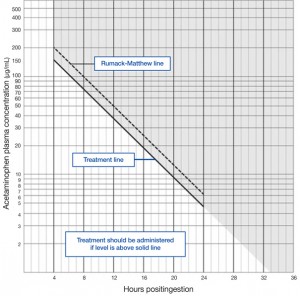Lit of the Week – 3/29/16
Rumack BH, Peterson RC, Koch GG, Amara IA. Acetaminophen overdose. 662 cases with evaluation of oral acetylcysteine treatment. Arch Intern Med. 1981 Feb 23;141(3 Spec No):380-5. PubMed PMID: 7469629.
http://www.ncbi.nlm.nih.gov/pubmed/7469629
Clinical question / background:
- Does N-acetylcysteine prevent or moderate hepatotoxicity secondary to acute acetaminophen overdose?
Design:
- Nationwide, multiclinic open study
- Started in 1976 at the Rocky Mountain Poison Center, Denver
- 662 consecutive patients with acetaminophen overdose
- Inclusion: Age > 12 y/o, history of known or suspected acute ingestion of 7.5 g or more of acetaminophen within 24 hours of presentation, plasmal acetaminophen level in toxic range on the nomogram
- Exclusion: ingestion > 24h old
- Primary outcome: incidence of hypotoxicity secondary to acute acetaminophen ingestion
- Clinically significant hepatotoxicity defined as AST > 1000 IU/L
- Patients grouped based on time of ingestion to administration of NAC
- < 10 hours
- 10-16 hours
- 16-24 hours
- Secondary outcomes: mortality, safety of oral NAC
Intervention:
- NAC loading dose: 140 mg/kg PO x 1
- NAC maintenance dose: 70 mg/kg PO q4 for 17 additional doses
- Supportive measures, gastric lavage up front
Control:
- None
Results:
- Incidence of hepatotoxicity and time to treatment for patients with acetaminophen concentration in probable toxic range (line intersecting 200 mg/mL (1324 mmol/L) at 4 hours and 50 mg/mL (331 mmol/L) at 12 hours) were:
- 7% when treated within 10 hours of ingestion
- 29% when treated within 10 to 16 hours of ingestion
- 62% when treated within 16 to 24 hours of ingestion
- Statistically significant trend in reduction severity of toxicity with earlier onset of NAC treatment
- Alcohol congest as possible protective effect
Take-home:
- NAC is a safe and effective management option of acetaminophen overdose and its effects are more beneficial with early administration < 10 hours after overdose ingestion
Strengths:
- Large study
- Simple protocol with reproducible results in subsequent studies
- Mainstay of treatment for acetaminophen overdose remains NAC
Weaknesses / Critiques
- No control
- Unable to ascertain effects on chronic ingestion
- PO administration only
Follow-up / Real World Application
- Acute Acetaminophen Ingestion – remember that Rumack-Mathew Nomogram ONLY for acute ingestions
- VERY IMPORTANT to ascertain INGESTION TIME – use EARLIEST if patient took multiple ingestions over a period of hours
- Call Poison control center à 5-9000, ext 2; (404-616-9000 ext. 2)
- Ingestion < 4 hours
- AC if < 3 hours post-ingestion
- Send 4-hour APAP level and treat if necessary
- Ingestion 4-24 hours
- If APAP level available by 8 hours post-ingestion, can wait before starting NAC
- If APAP level will be available > 8 hour post-ingestion or patient presenting > 8hours post ingestion, START NAC and send APAP level to guide treatment
- Ingestion > 24 hours or unknown ingestion time
- Send APAP level, LFTs, Coags, ABG
- Give 1st dose of NAC
- If APAP level > 10, or elevated LFTs à continue NAC
- pH <7.3, PT > 100, Cr >3.3 or AMS, consider transplant eval
- If APAP level normal and LFTs wnl, stop NAC
- NAC Dosing
- PO – 72 hr protocol
- 140 mg/kg PO load
- 70 mg/kg PO q4hr x 17 additional doses
- IV – 21 hr protocol
- Load: 150 mg/kg in 100 mL D5W over 60 min
- Maintenance: 50 mg/gk in 250 mL D5W over 4 hrs
- Third dose: 100 mg/kg in 500 mL D5W over 16 hrs
- PO – 72 hr protocol
- Ingestion < 4 hours

